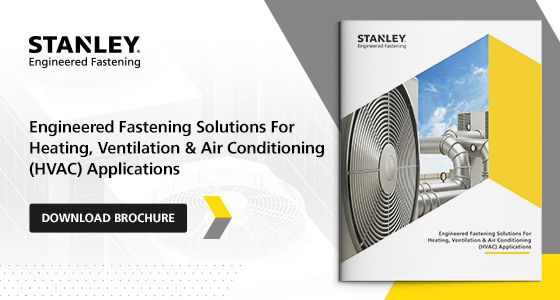Solving Vibration and Thermal Shock Challenges in Heating, Ventilation & Air Conditioning (HVAC) Systems
Fastening Integrity - The Hidden Link in HVAC Designs
As HVAC systems become more compact and energy-efficient, their internal components are subjected to more frequent and intense mechanical stress. Constant fan operation, compressor cycling, and environmental exposure all contribute to high levels of vibration and thermal shock. Over time, these stresses can compromise the integrity of mechanical joints—especially if the fastening solution is not designed to absorb or resist them. In HVAC assemblies, failures in fasteners can lead to issues ranging from buzzing noises and panel separation to complete structural loosening, reducing system reliability and increasing the need for service or replacement.
Understanding the Stress: Vibration and Thermal Shock in HVAC
The HVAC environment is uniquely harsh on joints. Fans and compressors create cyclical vibration; heating and cooling cycles cause expansion and contraction of components at different rates; outdoor installations expose systems to temperature swings and moisture ingress. Over time, even minute joint movement under these stresses can cause fasteners to loosen, fatigue, or corrode—leading to system failures that are difficult to predict or inspect. For modular or high-speed HVAC manufacturing lines, this becomes a compounded risk: hundreds or thousands of units are assembled under tight timelines, and manual fastening operations may lack consistency across different grip ranges or material stacks if not followed an automation process.Case Study: How A Modular Air Conditioning Chassis Manufacturer Reduced the Vibration-induced strip-out in fasteners by Switching from Traditional Nut & Bolts to Blind Riveting
Our team has recently worked with a manufacturer of modular chassis parts for air conditioning units that faced several challenges:
- Vibration-induced strip-out in fasteners
- Limited access, requiring fasteners that could be installed from one side
- Thermal shock causing joint loosening due to constant airflow
- A wide range of part variations requiring multiple SKUs of bolts and washers
Their traditional fastening approach—bolts, nuts, and washers—required two workers and extended cycle time. Additionally, it didn’t offer adequate vibration or corrosion resistance.
Their traditional fastening approach—bolts, nuts, and washers—required two workers and extended cycle time. Additionally, it didn’t offer adequate vibration or corrosion resistance
To address these problems, the manufacturer transitioned to blind fastening technology, specifically they tried the Avdel® Monobolt® 6.6 mm stainless steel fastener. This structural blind rivet offered:
- One-sided installation
- High tensile and shear strength
- Excellent vibration resistance
- Multi-grip capability to handle part variation
- Reduced need for torqueing or secondary tightening
Reduced need for torqueing or secondary tightening
Why Choosing the Right Fastening Solution Matters
In HVAC systems, the right fastening solution goes beyond fit and function—it must absorb vibration, resist thermal stress, and maintain joint integrity under repeated loading. Structural rivets like Monobolt®, Avibulb® XT, and NeoBolt® are designed with wide bearing areas, multi-grip capability, and strong bulbing or collar lock features that provide lasting stability. These features reduce the likelihood of micro-movement at the joint, which is critical in minimizing long-term fatigue and maintaining alignment—even under constant operation. Fasteners are often one of the last components considered in HVAC product design, yet they are among the first points of failure when stress conditions are underestimated. By choosing vibration-resistant, thermally stable fastening systems early in the design phase, manufacturers can significantly extend product life, reduce field service rates, and improve customer satisfaction.
